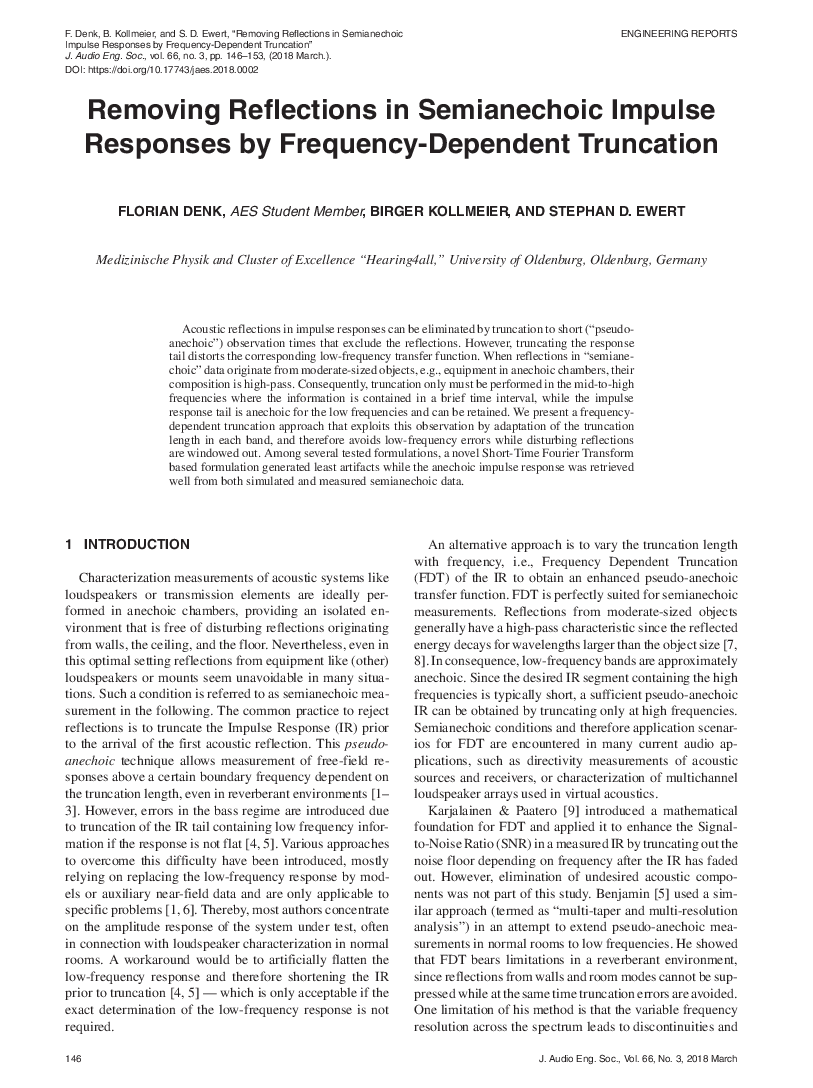Home / Publications / E-library page
You are currently logged in as an
Institutional Subscriber.
If you would like to logout,
please click on the button below.
Home / Publications / E-library page
Only AES members and Institutional Journal Subscribers can download
Acoustic reflections in impulse responses can be eliminated by truncation to short observation times that exclude the reflections. However, truncating the response tail distorts the corresponding low-frequency transfer function. When reflections in ”semianechoic” data originate from moderate-sized objects, e.g., equipment in anechoic chambers, their composition is mostly high frequencies. Consequently, truncation must only be performed in the mid to high frequencies where the information is contained in a brief time interval; the impulse response tail is anechoic for the low frequencies and can be retained. The authors present a frequency-dependent truncation approach that exploits this property by adapting the truncation length in each band. This avoids low-frequency errors while disturbing reflections are windowed out. Among several tested formulations, a novel Short Time Fourier Transform-based formulation generated the least artifacts while the anechoic impulse response was well preserved in both simulated and measured semianechoic data.
Author (s): Denk, Florian; Kollmeier, Birger; Ewert, Stephan D.
Affiliation:
Medizinische Physik and Cluster of Excellence
(See document for exact affiliation information.)
Publication Date:
2018-03-06
Import into BibTeX
Permalink: https://aes2.org/publications/elibrary-page/?id=19382
(769KB)
Click to purchase paper as a non-member or login as an AES member. If your company or school subscribes to the E-Library then switch to the institutional version. If you are not an AES member Join the AES. If you need to check your member status, login to the Member Portal.

Denk, Florian; Kollmeier, Birger; Ewert, Stephan D.; 2018; Removing Reflections in Semianechoic Impulse Responses by Frequency-Dependent Truncation [PDF]; Medizinische Physik and Cluster of Excellence; Paper ; Available from: https://aes2.org/publications/elibrary-page/?id=19382
Denk, Florian; Kollmeier, Birger; Ewert, Stephan D.; Removing Reflections in Semianechoic Impulse Responses by Frequency-Dependent Truncation [PDF]; Medizinische Physik and Cluster of Excellence; Paper ; 2018 Available: https://aes2.org/publications/elibrary-page/?id=19382
@article{denk2018removing,
author={denk florian and kollmeier birger and ewert stephan d.},
journal={journal of the audio engineering society},
title={removing reflections in semianechoic impulse responses by frequency-dependent truncation},
year={2018},
volume={66},
issue={3},
pages={146-153},
month={march},}